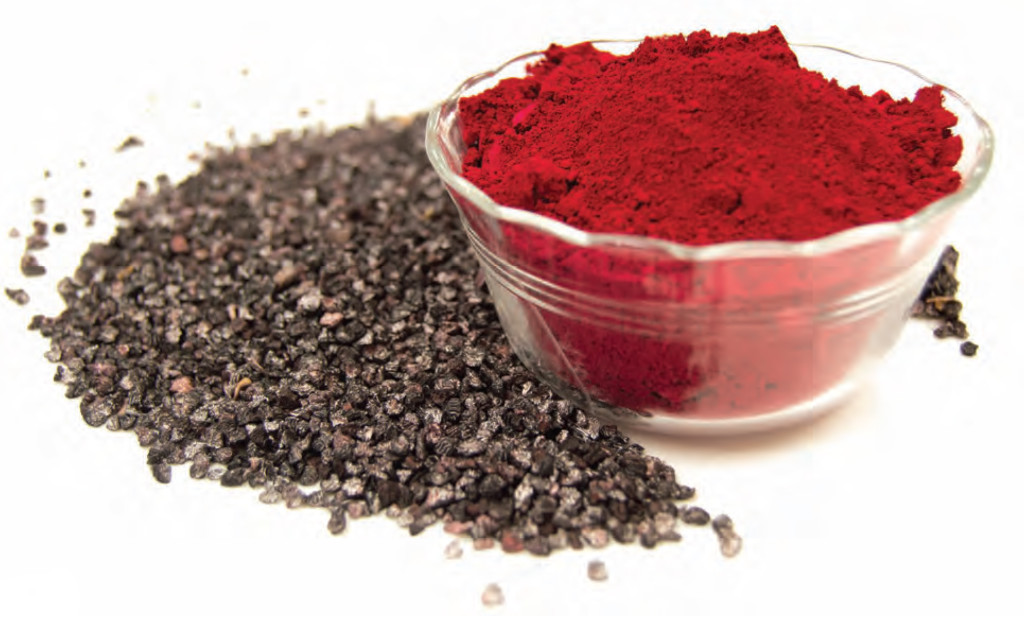Carmine is a vivid red pigment that comes from the dried bodies of scale insects (Dactylopius coccus costa) native to South America and Mexico that parasitize cactus plants. It is one of the most stable natural colorants and can withstand heat treatment and light exposure.
It is used as a food dye and in paints, rouges, and other cosmetics. It is also a stain used in microbiology.It’s made from insectsCarmine is one of the red dyes found in all sorts of foods and body products, ranging from candy and ice cream to lipstick and kids’ snacks. It can also be found as an ingredient in makeup, but it’s important to note that this isn’t the same thing as synthetic food colorants like Red dye 40 (which comes from coal tar or petroleum).The cochineal bug (Dactylopius coccus Costa) produces a predator-deterring substance known as carminic acid. When crushed, this substance yields a red dye that the Aztecs first used to dye fabrics. Today, the dye is primarily harvested in Peru and the Canary Islands.The insect is then boiled, filtered, and mixed with basic aluminum salts to produce the bright red lake dye known as Carmine. The fact that it’s derived from insects has made some people wary of its use, particularly those who follow a vegan diet. However, the dye has been proven to be safer than the synthetic red and purple FD&C and lake dyes currently used in the US.It’s a food additiveCarmine is used as a food coloring additive and may be found in many products, including sausages, canned tuna, cakes, pastries, and ice cream. It is also an ingredient in some pharmaceutical drugs. It is available in powder and liquid form. It is stable at varying pH levels and in the presence of heat and light. It is an inexpensive dye that is popular among cosmetic manufacturers and food companies.In the United States, foods containing Carmine must be labeled as such. In Europe, it is listed as cochineal extract, carminic acid, and natural red 4 and designated as additive E 120 in the European list of approved food additives.However, some people are allergic to it. These reactions include asthma, rhinoconjunctivitis, and hives. The FDA requires that products containing Carmine be clearly labeled as such. Its use is controversial for some groups, such as vegans and those following religious dietary restrictions (Halal or Kosher). The FDA will continue to review the safety of Carmine in light of new scientific data.It’s a dyeCarmine is a red dye that comes from the bodies of female cochineal insects. These bugs live as parasites on cactus plants, and they produce a pigment in their bodies that can be used for dying. This pigment is used in a wide variety of products, including food and cosmetics. However, it has been linked to severe allergic reactions in some people.To make carmine, producers crush the insects and extract their coloring agents. These agents are then combined with aluminum calcium salts to produce brilliant red dyes. The result is a natural ingredient that’s a safer alternative to synthetic dyes like Red 40, which has been linked to asthma and other health problems.Carmine is also known as cochineal extract, crimson lake and natural red 4. It can be found in many beauty products, particularly those that claim to be vegan. But it’s important to check the label carefully, as some companies use carmine in their formulas without declaring it on the ingredients list.It’s a source of concernCarmine is a natural dye and pigment derived from the bodies of female cochineal insects (Coccus cacti) that live on cacti. It is used in food and cosmetics. It can be used to achieve a bright red color. It is also found in lipstick and other cosmetic products. It is also a popular alternative to coal tar based colorants.The preparation of this dye involves boiling dried insect bodies to extract carminic acid. It is then treated with a clear solution of alum to precipitate the pigment. Aluminum ions in alum form complex salts with the acid, producing an intense crimson-red color. The resulting pigment can be used in a wide variety of foods, including ice cream, confectionery, culinary, beverages and dairy products. It is also found in cosmetics and pharmaceuticals.Despite its long history of use, it is a source of concern for some people. It is not suitable for vegans because it is made by boiling and grinding up the bodies of beetles. Consequently, many companies are now using other dyes to avoid this controversy.
